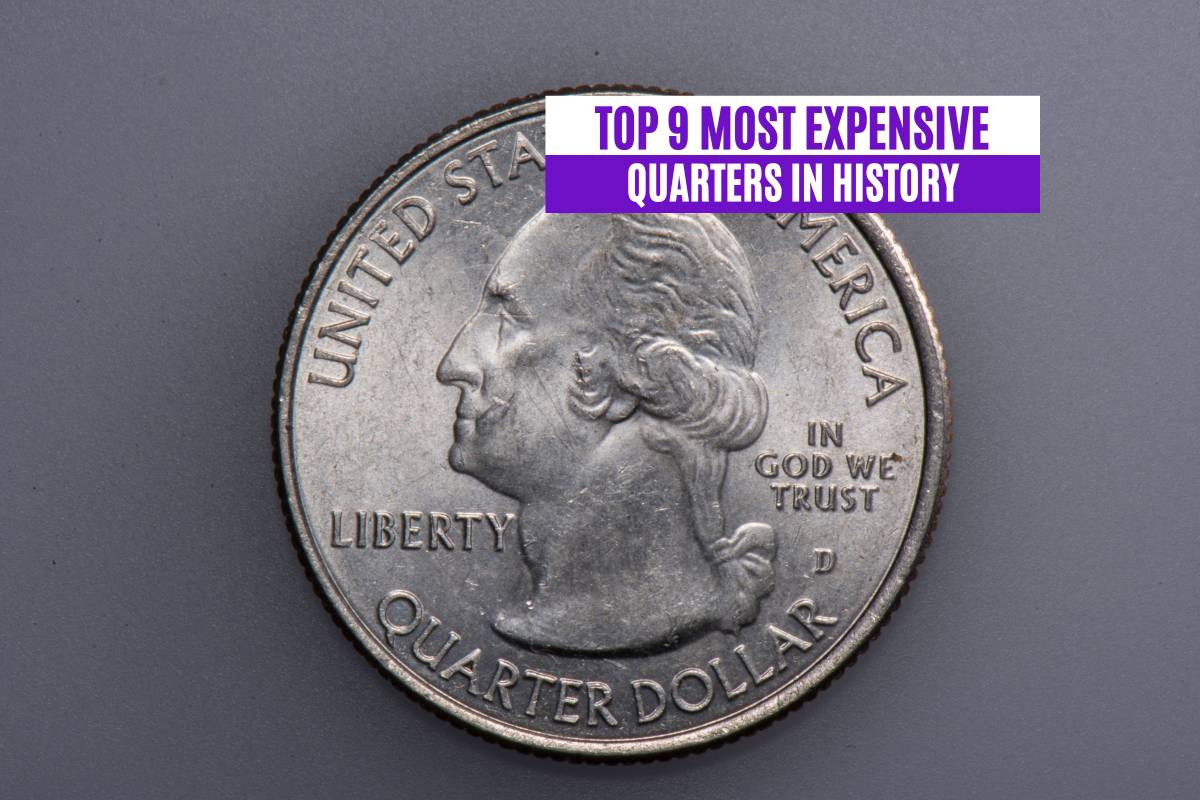The 25-cent quarter existed almost a full century before the introduction of paper money! Consequently, some quarters are almost as old as the United States itself. Quite a few of these coins are worth far more than their listed worth, but which are the most valuable?
The most expensive quarter in history is the 1796 Draped Bust Quarter. This quarter sold for $2.35 million in 2022. Notably, the 1796 Draped Bust Quarter is the first 25-cent piece created by the U.S. Mint, so it’s a historically significant coin.
While most quarters are worth $0.25, some are worth hundreds of thousands of dollars. This ranking will reveal which of these coins fetch top-dollar prices.
Here Are the Top 9 Most Expensive Quarters in History:
- 1796 Draped Bust Quarter – $2.35 million
- 1827 Proof Capped Bust Quarter – $705,000
- 1807 Draped Bust Quarter – $630,000
- 1901-S Barber Quarter – $550,000
- 1839 Proof Liberty Seated Quarter (No Drapery) – $517,500
- 1873-CC Liberty Seated Quarter (No Arrows) – $470,000
- 1850 Proof Seated Liberty Quarter – $460,000
- 1871-CC Seated Liberty Quarter – $456,000
- 1823 Proof Capped Bust Quarter – $396,652
9. 1823 Proof Capped Bust Quarter – $396,652
Rarity Scale: R-9
Grade: PCGS PR-64
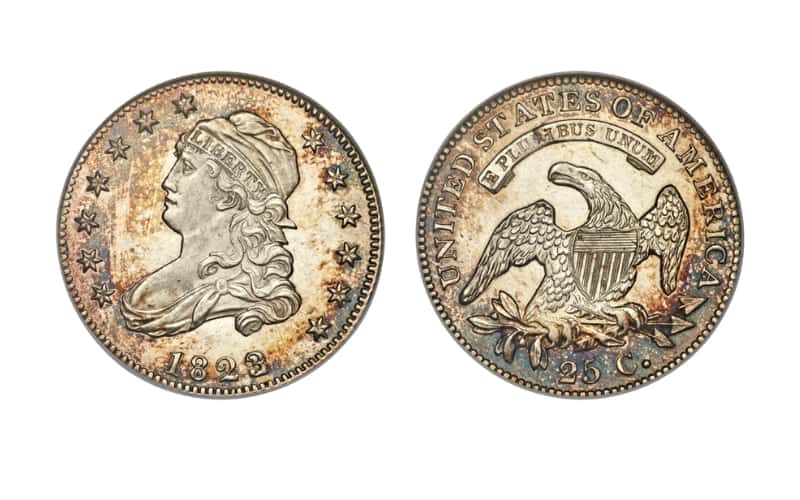
The 1823 Proof Capped Bust Quarter (also called the 1823/2 Proof Capped Bust Quarter) is a bit of an enigma. There aren’t any records of this coin’s creation, so it’s unclear how many were struck.
But it’s believed that only one of these proof coins exists, making it entirely unique (potentially). This quarter is also in top-notch condition, with virtually zero signs of damage.
One of the defining aspects of this coin is its dating.
Struck in 1823, the die initially used to produce this coin was from the 1822 set, so the coin was struck twice to correct this mistake, resulting in a visible “2” beneath the “3” on the year.
This quarter sold for $396,652 when it went to auction in 2014!
This antique quarter is so valuable that you could sell it and use the funds to purchase several of the most expensive Yeezy sneakers. Of course, those sneakers might not appreciate as well as this quarter.
Why Is It So Expensive?
This antique U.S. quarter is a coin collector’s dream come true for multiple reasons. Not only is it a one-of-a-kind piece, but it’s also in excellent condition.
If you had this quarter in your coin collection, you’d be the caretaker of an irreplaceable physical asset and a unique piece of U.S. history.
8. 1871-CC Seated Liberty Quarter – $456,000
Rarity Scale: R-8
Grade: PCGS MS-65
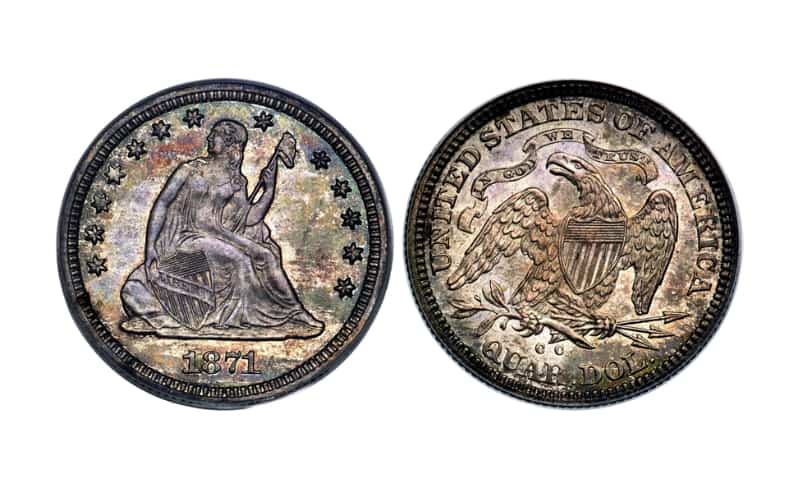
The 1871-CC Seated Liberty Quarter’s “CC” designation means that it was minted at the Carson City Mint facility.
This branch of the U.S. Mint officially shut its doors in 1899, so quarters struck there tend to be somewhat rare and historically significant. The 1871-CC Seated Liberty Quarter is no exception.
Only about three of these coins exist, making it one of the scarcest U.S. quarters.
When this coin went to auction in 2022, it sold for $456,000. That’s more than 1.8 million times its original denomination (25 cents)!
Why Is It So Expensive?
Like many other high-value quarters, this coin’s value stems from its rarity, historical significance, and exceptional condition. The fact that it was minted at the now-defunct Carson City Mint also boosts its value.
7. 1850 Proof Seated Liberty Quarter – $460,000
Rarity Scale: R-8
Grade: NGC PR-68
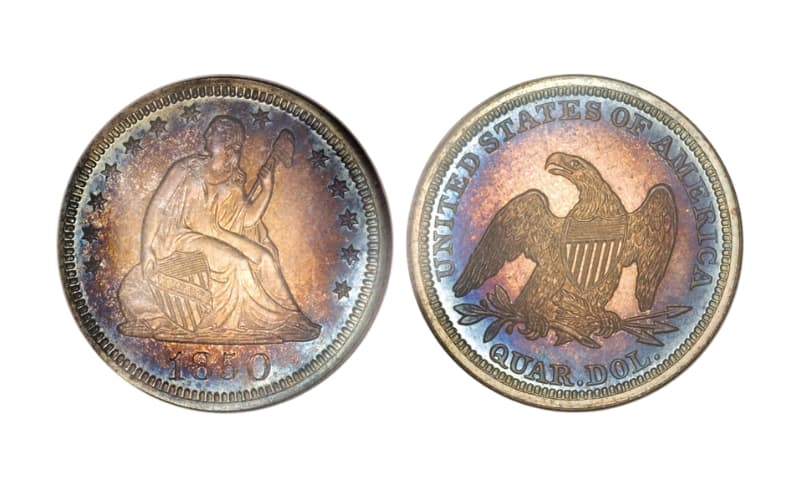
Quarters with a Sheldon Rarity Scale rating of R-8 are often quite pricey, as they’re typically one of up to only three specimens in existence.
But the R-8 1850 Proof Seated Liberty Quarter that sold at auction in 2008 is the highest-quality of its few counterparts. For this reason, this quarter sold for $460,000.
Notably, this quarter never entered circulation. Instead, it was a special proof coin explicitly struck for collectors and high-ranking government officials.
Why Is It So Expensive?
Proof coins are almost always more valuable than circulation coins, as they show the die images more clearly and are generally kept in better condition.
This quarter is valuable because of its proof status and near-perfect condition. Of course, the fact that it’s one of only about three also makes it a rare find, which only helps to make it pricier.
6. 1873-CC Liberty Seated Quarter (No Arrows) – $470,000
Rarity Scale: R-7
Grade: PCGS MS-64
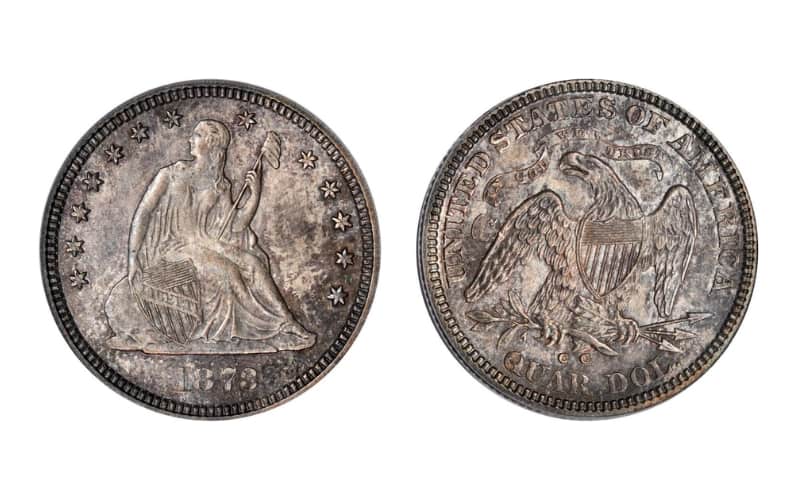
When the Carson City Mint closed its doors in 1899, every quarter ever struck there immediately became a collectible coin.
That’s certainly true of the mint-condition 1873-CC Liberty Seated Quarter (without arrows) that sold for $470,000 in 2012.
This Carson City Mint coin is just one of five left, and it’s one of the few kept uncirculated. And while most of the quarters struck during this year feature arrows pointing outward from the year date, this one does not.
If you sold this quarter, you could afford to stay almost a full week in NYC’s most expensive hotel suite!
Why Is It So Expensive?
There are quite a few reasons why this particular quarter is so valuable.
For example, there’s the fact that it’s just one of five, its lack of standard-die arrows by the date, and its superb condition. The combination of these qualities makes it inherently valuable to collectors.
5. 1839 Proof Liberty Seated Quarter (No Drapery) – $517,500
Rarity Scale: R-9
Grade: NGC PR-65
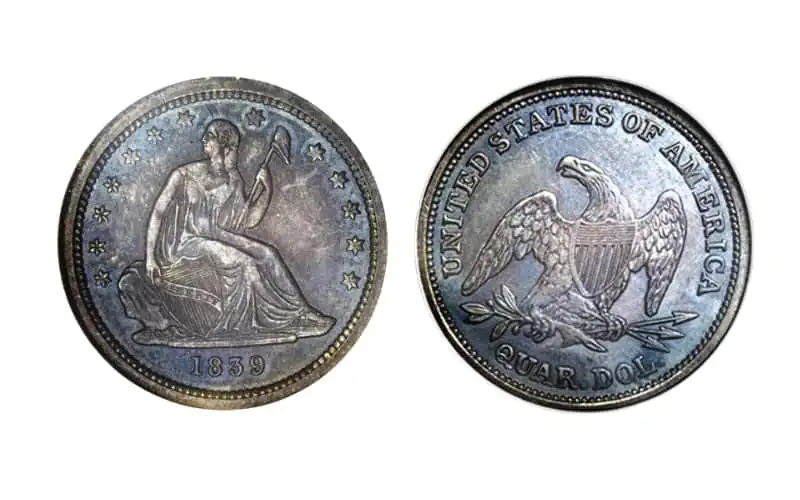
Coins with an R-9 designation are one-of-a-kind, irreplaceable pieces. This makes them hard-to-find acquisitions for coin collectors, and it also means they can fetch outrageous prices when they go to auction.
Take the 1839 Proof Liberty Seated Quarter (with no drapery), for example. This proof coin is the only one of its type, and despite its few marks and light scratches, it sold for an astounding $517,500 in 2008.
Why Is It So Expensive?
This quarter has only enjoyed a handful of owners since its creation. Finding it for sale is almost equivalent to seeing a unicorn.
As such, coin collectors tend to jump at the chance to bid on this specimen, causing prices to skyrocket. This isn’t entirely surprising, especially considering that this proof coin is one-of-a-kind.
4. 1901-S Barber Quarter – $550,000
Rarity Scale: R-9
Grade: PCGS MS-68
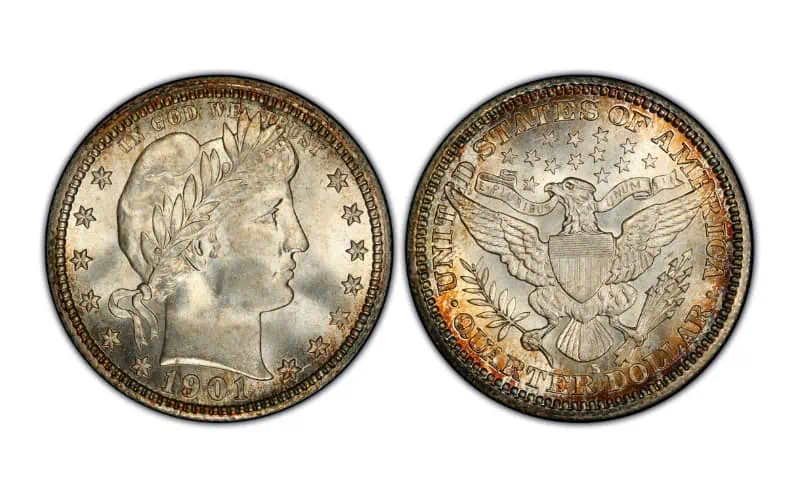
Unless you’re an avid U.S. coin collector, you might be unfamiliar with the name Charles E. Barber.
This man was one of the most significant engravers working at the U.S. Mint during the early 20th century, and the coins he helped design and create are often called “Barber coins.”
The most valuable of these coins, which vary from dimes to half dollars, might be the 1901-S Barber Quarter. This coin sold for $550,000 in 1990. Today, it could probably fetch a much higher price.
Why Is It So Expensive?
Condition is the name of the game when it comes to this quarter’s jaw-dropping value. Never before (or since) has there been a Barber quarter with such a high grading (MS-68).
3. 1807 Draped Bust Quarter – $630,000
Rarity Scale: R-7
Grade: PCGS MS-67
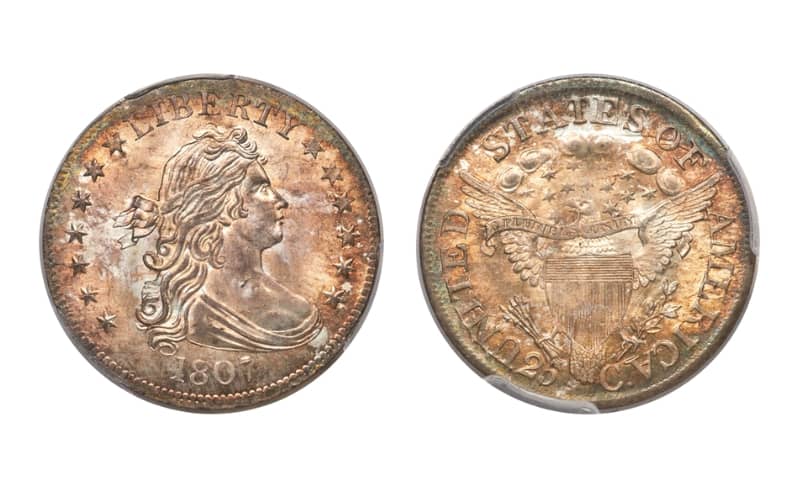
At first glance, the copper-colored 1807 Draped Bust Quarter might not look like much of a find. After all, it doesn’t have a silvery gleam like many other antique, high-value quarters.
But this quarter (one of about 12 known specimens) is unique because of its coloration. Well, that and its condition.
As you might imagine, keeping a coin in tip-top shape for more than two centuries can be challenging. So, when this quarter went to auction in 2020, it sold for no less than $630,000.
Why Is It So Expensive?
Condition and rarity are the two factors that make this particular brown-colored quarter valuable. It’s unlikely that any other 1807 Draped Bust Quarter with a similar coloration can match this coin’s condition.
2. 1827 Proof Capped Bust Quarter – $705,000
Rarity Scale: R-7
Grade: PCGS PR-66
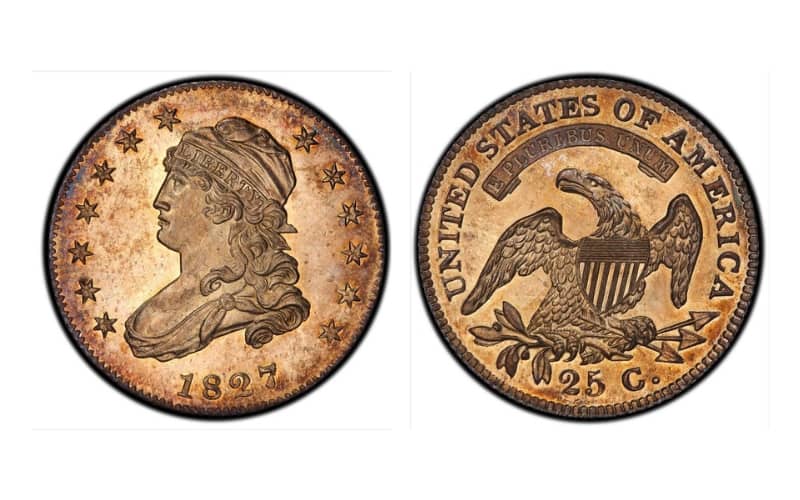
The 1827 Proof Capped Bust Quarter (also called the 1827/3/2 Capped Bust Quarter) shares one major similarity with the 1807 Draped Bust Quarter that sold for $630,000; it’s brown!
Only nine of these coins are left, and they all feature signs of “overdating,” a process by which a die is altered slightly to fit a new coin year. This is the reason behind the coin’s 1827/3/2 name.
If you have a keen eye, you might be able to spot a “3” beneath the “7” on this coin’s year. Of course, it’s easier to see this overdate in person, but you’d have to spend quite a fortune to make this quarter yours.
When a rare proof version of the 1827 Capped Bust Quarter went to auction in 2015, it sold for $705,000!
Why Is It So Expensive?
Although quarters with a noticeable overdate might be considered flawed by some collectors, they’re rare treasures for others.
This proof quarter’s condition, coupled with its copper tint and strike flaws, make it almost one-of-a-kind. Naturally, these qualities make it appealing to passionate collectors, many of whom instantly recognize the coin’s high value.
1. 1796 Draped Bust Quarter – $2.35 million
Rarity Scale: N/A
Grade: PCGS MS-66 CAC
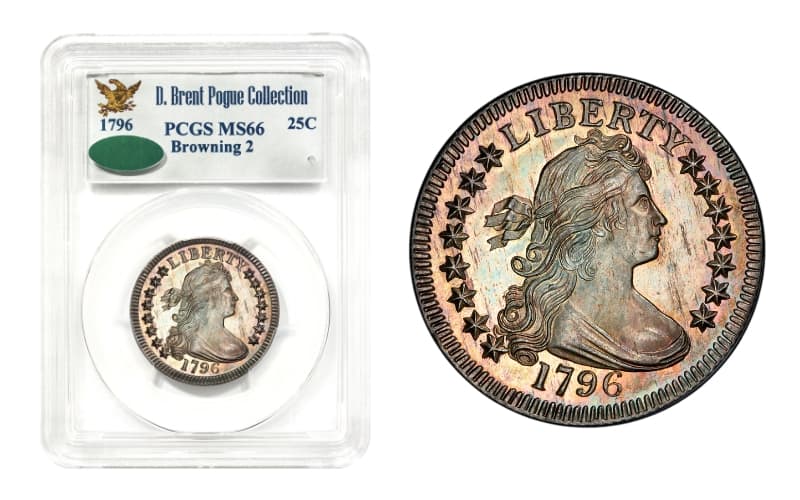
The most expensive quarter is the 1796 Draped Bust Quarter. This quarter sold to the GreatCollections auction house for $2.35 million in 2022.
The 1796 Draped Bust Quarter was the first 25-cent piece produced by the U.S. Mint. This was before the U.S. Mint established several different minting locations, so all of these quarters were struck in Philadelphia.
At this point in history, the U.S. government was still attempting to standardize the nation’s currency. One of the most notable aspects of the 1796 Draped Bust Quarter is its lack of denomination notation (it doesn’t say 25 cents anywhere on the coin).
Unlike modern quarters, primarily composed of copper and nickel, the first 1796 quarters were 89% silver, making them inherently more valuable than today’s in-circulation coins. After all, silver is one of the most expensive precious metals!
The quarter that sold for millions in 2022 features the B-2 die pair pattern. A coin die is a metal stamp used to imprint images on coins while they’re very hot and malleable.
The fact that this quarter features some of the earliest and original die pair patterns indicates that it was likely one of the first U.S. quarters created and delivered in 1796.
Despite its age, it’s in excellent (near-gem) condition, making it a holy grail for U.S. coin collectors.
Why Is It So Expensive?
In the history of coins, there might not be another with more U.S. historical significance.
The 1796 Draped Bust Quarter was the first quarter ever produced by the U.S. Mint, and the one that sold for millions in 2022 was part of the very first batch ever struck and delivered. New quarters weren’t struck again until 1804!
However, the condition also plays a role in this coin’s pricing. This particular 1796 Draped Bust Quarter has an MS-66 grading, meaning it’s almost flawless.
Considering that the coin is more than 200 years old, it’s incredible that it has remained in such stellar condition. In short, this quarter is truly worthy of its multi-million-dollar sales price.
What Makes a Quarter Valuable?
Apart from the assigned denomination (25 cents), the things that make a quarter valuable are:
- Age and composition
- Condition
- Historical significance
- Scarcity
If you’re considering starting a coin collection, you’ll want to familiarize yourself with these crucial factors. After all, age, scarcity, condition, and historical significance impact not only the value of U.S. quarters but all coins.
Age and Composition
It’s no coincidence that all the most expensive quarters are over a century old. Age can significantly increase a quarter’s value.
But unlike some antiques, many of which are valuable simply because they’re old (and therefore rare), old quarters tend to be exceptionally valuable due to their silver content.
Before the Coinage Act of 1965, the U.S. Mint struck quarters using silver. Quarters struck before this act are about 90% silver, making them worth more than their listed denomination.
Although silver values fluctuate over time, most pre-1965 quarters are worth more than $3 based on their silver content alone.
Condition
A coin’s condition (often reliant on coin strike types) is also a significant factor that impacts its overall value.
Coins that have been heavily circulated tend to show obvious signs of wear and tear, like scratching along the surface or discoloration.
But uncirculated and proof coins (PR) are often in mint (like-new or entirely unblemished) condition. These types of coins are typically more valuable due to their superior condition.
The Sheldon Grading Scale is used to assign a condition rating to quarters. A coin’s highest rating on the quarter grading scale is MS-70 (Uncirculated Perfect), with AG-3 (About Good) being the lowest grading.
Several of the most valuable quarters of all time feature grades of MS/PR-64 or higher, meaning that they’re essentially perfect, untouched, and uncirculated.
Historical Significance
How were ancient coins made? Much the same way that many of the earliest U.S. coins were made!
Precious metals were heated until they were liquified and malleable, then placed into a metal die with an imprinted image to cool. These early coins hold a ton of historical significance due to their unique striking process.
The most expensive quarter in history, the 1796 Draped Bust Quarter, is a fantastic example of how historical significance can impact quarter values. This quarter was the first 25-cent piece created by the U.S. Mint, and only about 6,000 were produced in 1796.
For perspective, the U.S. Mint struck more than a billion quarters in 2020!
Scarcity
When the U.S. Mint releases millions of a specific type of quarter, that quarter is instantly worth much less than quarters that are part of a much smaller release pool.
For example, quarters produced in small batches during low-yield years are more valuable than those created in large batches during high-yield years. Sheldon’s Rarity Scale expresses this concept beautifully, utilizing a numbered system to describe a quarter’s scarcity.
The rarest quarters earn an R-9 rating (or the “Unique” title). The most common ones earn an R-1 rating, signifying that more than 1,250 of the same coin exists.
What’s the Most Expensive Quarter?
The 1796 Draped Bust Quarter is the most expensive quarter in U.S. history. Although the U.S. Mint was established in 1792, it didn’t produce quarters until 1796, making the 1796 Draped Bust Quarter the first official $0.25 piece.
The GreatCollections currency auction house purchased this quarter in 2022 for $2.35 million. Just over 6,000 Draped Bust Quarters were minted in 1796, so they’re quite rare.
Check out these related articles to learn more about the world’s most expensive items and experiences!

